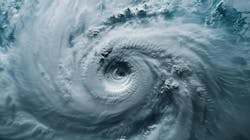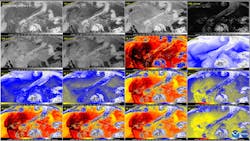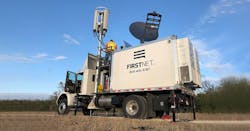Monitoring Hurricanes and Mitigating the Aftermath with Advanced Tech
What you’ll learn:
- Insight into the latest weather forecasting technologies.
- Mitigating damage with the latest hardware.
- What’s being done to help in rescue and restoration efforts.
As the U.S. battles through the hurricane season, and deals with the aftermath of Helene and Milton, it's important to know what technologies play a leading role in monitoring and tracking hurricanes and what others do to help mitigate their aftermath. Hurricanes often cause extensive property damage, can cripple infrastructure, and cause the loss of life. In this situation, government agencies and nonprofit organizations require fast, updated solutions to forecast and monitor hurricanes and minimize damage.
Advances in Hurricane Forecasting
Today, scientists take advantage of several tools to monitor weather events and track hurricanes on the ground, in the sky, and in space. Aircraft, satellites, drones, and unmanned aerial vehicles (UAVs) are only a few of the solutions that help scientists forecast and track hurricanes.
They exploit the data garnered from satellites and other devices to develop sophisticated models that predict important factors about hurricanes, such as intensity and size, and help produce accurate hurricane tracking. Several data points are used to create accurate hurricane models, including oceanic temperatures, wind speed and direction, changes in ocean salinity—even the presence of El Nino is taken into account.
Of course, some advances in hurricane monitoring and tracking have emerged over the last decade or so, and scientists have capitalized on the tech step-up to create next-gen tracking methods. These new platforms provide accurate predictions of hurricane movement, protect people on the ground, and aid rescue and restoration efforts. Some of those latest tools include:
- The GOES-R satellite system: The US National Oceanic and Atmospheric Administration (NOAA) developed the GOES-R satellite system (Fig. 1), which allows scientists to monitor hurricanes and other storms in their infancy. High-resolution imaging and fast refresh rates make it possible for meteorologists to issue more accurate warnings when a hurricane is approaching.
- The Global Hawk UAV: UAVs have become critical tools for hurricane forecasting as they allow meteorologists to take measurements remotely. The Global Hawk UAV can fly over severe weather, loiter on-site, and achieve high altitudes for hours, providing surveillance and garnering data to predict characteristics such as hurricane intensification.
- Internet of Things (IoT) sensors: IoT devices can collect data remotely from various sources, supplying a steady stream of real-time data for different use cases. Meteorologists use IoT sensors to monitor hurricanes, collecting data that researchers can use to support modeling and prediction.
- Oceanic gliders: Oceanic gliders collect underwater data from 1,000 feet below the ocean’s surface to analyze water conditions, including temperature and salinity, which can add or diminish hurricane intensity. The higher the water temperature and salinity, the stronger the hurricane.
Meteorologists routinely take advantage of new technologies to aid in weather forecasting and tracking, and have even employed AI, deep learning, and machine learning to model hurricane trajectories and their evolution. Local communities and first responders can also deploy pop-up networks for temporary connectivity, along with satellite constellations, such as SpaceX’s Starlink and Sateliot's nanosatellites, following infrastructure outages.
Hurricane Mitigation Tools
Hurricanes can unleash significant damage if local and national organizations and governments fail to take preventative measures. The latest tracking technologies are able to provide advance warning to those in a hurricane’s path, while other technologies help mitigate the destruction hurricanes leave in their wake. Adopting new building techniques often help lessen property damage, while hardening infrastructure can keep vital services such as power and communications intact. Most coastal states that are frequently hit employ some of those measures.
Babcock Ranch in Florida is a testament to that notion, as the town never lost power or water or suffered any significant damage during or after Hurricane Ian struck in 2022. The town, which was built on a site 30 miles inland and 30 feet above sea level, has buried infrastructure, wetlands, and other features to resist storms. It relies solely on solar power for its energy needs (using 650,000 photovoltaic panels), has built storm-resistant housing, and maintains a wastewater management system that helps ensure clean drinking water.
Connectivity is Essential: Creating Pop-Up Networks
Beyond power, communication is another critical technology that’s relied on during and after natural disasters. Connectivity is key in providing faster rescue and restoration efforts. However, such connectivity can be scarce or outright gone after a hurricane hits and critical infrastructure suffers damage.
That’s where pop-up networks can come into play. Pop-up networks provide temporary wireless connectivity, helping first responders carry out important operations such as rescue efforts and medical care. Using a network of flying platforms, first responders and agencies are able to deliver wireless infrastructure to provide temporary connectivity.
Drones can be deployed to enhance network quality of service and improve network resilience during emergencies. They may also be outfitted with optical communication transceivers with extended battery life and 5G technology capabilities. While they only provide temporary connectivity to support disaster relief personnel, drones do enable device-to-device communications, a critical component in relief efforts. These capabilities are vital when important communications infrastructure, such as cellular networks, are damaged.
Moreover, 5G networks are useful during natural disasters, providing low latency, high bandwidth, and support for massive connectivity. That said, 5G cellular towers can also go down in hurricane-force winds, leaving people living in those areas without the ability to communicate with loved ones or first responders. FirstNet (The First Responder Network Authority), which was created just for these types of scenarios, is designed to establish, operate, and maintain an interoperable public safety broadband network.
FirstNet (Fig. 2) is part of the U.S. Department of Commerce's National Telecommunications and Information Administration (NTIA) and first came into service in 2012. The agency partnered with AT&T to bring in mobile platforms that provide communications coverage in damaged areas and remote locations.
AT&T recently launched a floating mobile hotspot near Sanibel Island, Florida, to assist emergency services in response and recovery efforts with wireless communications. The vehicles take advantage of the nationwide Band 14 spectrum set aside by the government specifically for FirstNet, as well as AT&T’s commercial 5G spectrum, to deliver stable communication networks.
Saving Lives Through Technology
Hurricane-tracking technology, drones, pop-up networks, and buried infrastructure have the potential to save human lives, reduce the risk of property loss, and restore critical power and services after a disaster. Scientists and meteorologists are continuously developing advanced, sophisticated weather forecasting and monitoring solutions as new technologies become available. Meanwhile, engineers develop and design new platforms that provide robust power and communications, making it easier and faster to deploy critical restoration and rescue efforts.
Mitigating damage and the loss of loved ones is a priority during natural disasters, and employing the latest technologies will only help in those efforts.
About the Author
Cabe Atwell
Technology Editor, Electronic Design
Cabe is a Technology Editor for Electronic Design.
Engineer, Machinist, Maker, Writer. A graduate Electrical Engineer actively plying his expertise in the industry and at his company, Gunhead. When not designing/building, he creates a steady torrent of projects and content in the media world. Many of his projects and articles are online at element14 & SolidSmack, industry-focused work at EETimes & EDN, and offbeat articles at Make Magazine. Currently, you can find him hosting webinars and contributing to Electronic Design and Machine Design.
Cabe is an electrical engineer, design consultant and author with 25 years’ experience. His most recent book is “Essential 555 IC: Design, Configure, and Create Clever Circuits”
Cabe writes the Engineering on Friday blog on Electronic Design.



